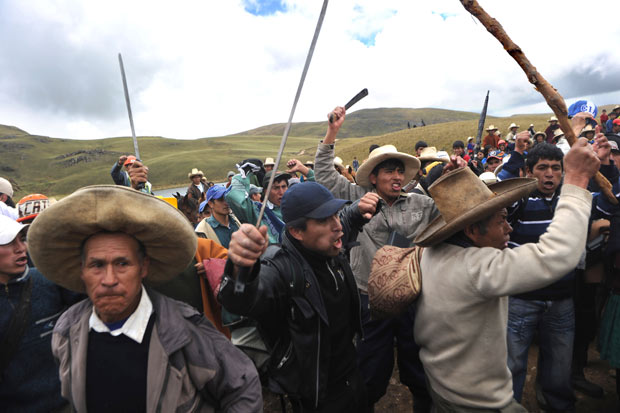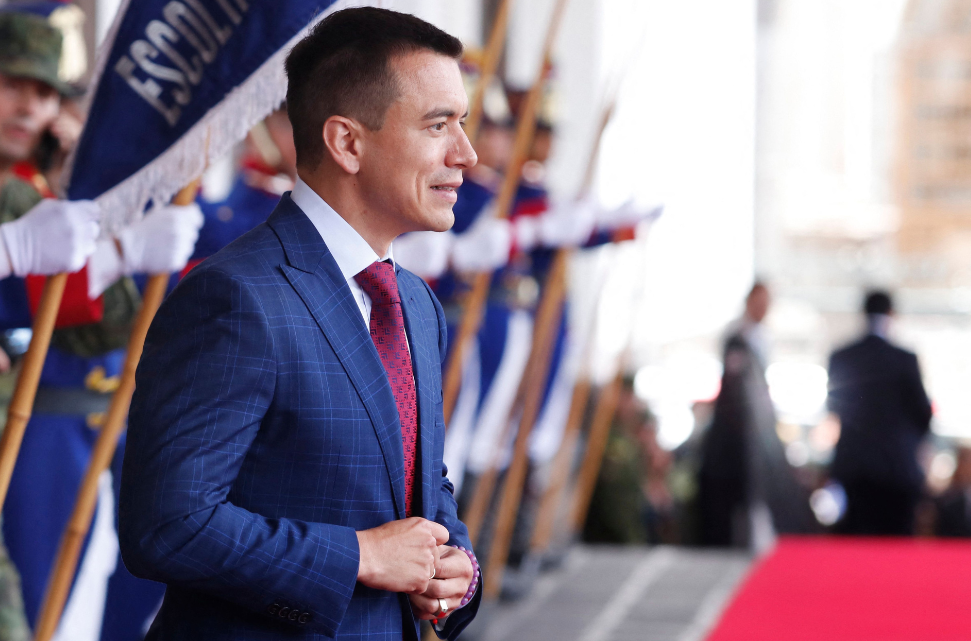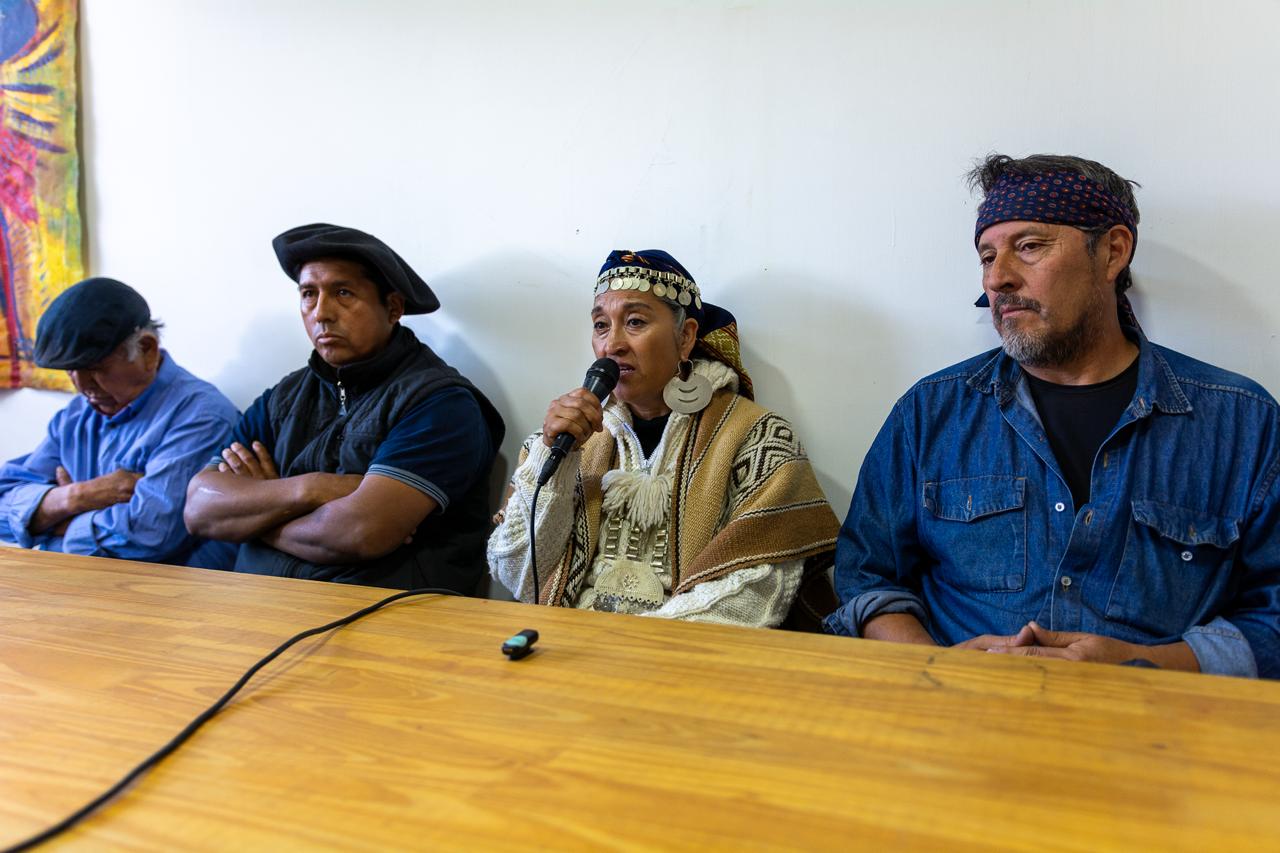After ending his first year in office, Ollanta Humala’s government seems to face a permanent crisis due to his inability to resolve key conflicts and demands. The brutal repression of protests against mining projects in the departments of Cusco and Cajamarca in the last few months has revealed an authoritarian streak within the government, and a distancing from the change agenda that helped the nationalist leader win the elections. But the call for major transformations is still strong in the protests spread around the country. Changes in the cabinet will not resolve the grassroots conflicts if not accompanied by a real change in policies.
In the northern department of Cajamarca, demonstrations against the Conga mining megaproject have gone on now for more than eight months. The project of the Yanacocha consortium with the participation of Newmont of Canada and the International Financing Corporation of the World Bank, threaten the system of lagoons and springs in the highlands of Cajamarca, while the majority of the population affected does not receive real benefits from the mining. While over the past months professors, fishermen, workers, women and students have demonstrated throughout Peru, protests against extractive industries have undoubtedly had the greatest impact.
The protests in Cajamarca have dragged on since dialogue between the national government and regional authorities, who oppose the project, broke down in late 2011. Although the Humala government imposed a series of additional requirements on Yanacocha, among them to assure access to water in the region by replacing affected lagoons with additional reserves, the two sides could not come to any agreements. In response to the protests, the government has declared a state of emergency twice. Dozens of grassroots leaders and politicians are facing charges (including the regional president, Gregorio Santos), the federal government blocked funds to the regional government and there have been constant reports of cases of police brutality.
In early July the conflict heated up, leading to a confrontation between police, soldiers and local residents. The government used violence against the opposition, leaving five people dead. Environmentalist leader, Marco Arana, was violently arrested and freed a few days later and a state of emergency was declared. The protests continued and the government chose to back off temporarily, asking Monsignor Cabrejos and Father Garatea to facilitate a dialogue with the political officials and grassroots leaders in the region. However, up to now both sides have held on to their respective positions on the project. The mediators admit that a solution will take time and is largely out of their hands.
The violence in Cajamarca came shortly after widespread protests against environmental pollution and the insufficient contributions to local development of the Xstrata mine in the province of Espinar in Cusco,. These protests resulted in battles with police, leaving two people dead and dozens wounded. There the central government also declared a state of emergency and blocked funds to the provincial government. Dozens of police violently arrested the provincial mayor, Oscar Mollehuanca.
The main leaders of the protest were detained, along with two human rights defenders from the Vicariate of Solidarity Sicuani (1). Despite the demand to hold them in “preventive prison”, they were freed some weeks after the confrontations. In Espinar, the government established negotiations with leaders and local authorities to find a way out of the conflict.
Protests against Conga shake up government and social movements
For the past years, disputes for territory and control of common goods–what we call “eco-territorial conflicts” (Svampa 2011)—cause most conflicts in the country. (2) The impact on politics and society has grown over the past months. Political analyst and former Vice-Minster of Environment in the Humala government, Jose de Echave, believes the conflicts have become more intense, “the political consequences of the conflicts are greater than ever. Never has a cabinet fallen due to a mining conflict and now there have been two in Peru, taking into account that the former Prime Minster Valdes also has been replaced for not being able to resolve the Conga case.”
Since Espinar, the ruling party’s parliamentary group has broken up. Protest the violence in Espinar, two representatives from Cusco (Veronica Mendoza y Rubén Coa), one from Cajamarca (Jorge Rimarachín), and the historic leaders of the left Javier Diez Canseco and Rosa Mavila resigned from the governing coalition Gana Peru. They hope to form their own group, for which they need one more member, and promote a transformation agenda.
The protests have also forced a more programmatic agenda for social movements. These not only reject specific projects, but also put forth the need for “different policies”.
A reconstruction of the first year of Humala’s government reveals that his administration’s policies have been determined in large part by relations with mining companies. In one of its first acts, the administration publicly announced a tax hike on the mining sector to support the social programs that Humala sought to promote. However, everything indicates that the president is firmly committed to supporting mining, even in cases of controversial projects that have been postponed or have problems in the implementation phase. Under the governments of Toledo and Garcia, projects in Ayavaca, Huancabamba, Tambogrande, Cajamarca and Islay did not move forward due to the opposition of local populations. Conga has become a test of whether the nationalist government can show its commitment to the current economic model, by using strategies to advance where more rightwing governments failed.
The opposition to the Conga mine marks a turning point in the process of rebuilding Peruvian grassroots organization. It is notable not only for its strength and longevity, but also because the different political tendencies within the protests have managed to remain united in action for months. The Unitary Committee of Struggle guaranteed that the protests were peaceful, symbolic and controlled, avoiding direct confrontations with state forces despite provocations from them.
They have also maintained coordination among grassroots leaders, mayors of the region around the project and the regional president—former grassroots leader Gregorio Santos—and all of those continuously join sides with the opposition to the project. They’ve also made common cause with the National March for Water, held in February, and a legislative initiative to declare water as a human right and protect the watersheds, making the Cajamarca resistance national with a strong program. Numerous studies, publications and media campaigns have come out to support the grassroots protests, which question the government’s version that the availability of water would not be affected by the project. All this shows the struggle in Cajamarca as a huge qualitative advance for Peruvian social movements in its political organizational and programmatic capacity.
A mining-military government?
What has happened in the last months presents major questions about the course of the nationalist government. Political analyst Santiago Pedraglio asked, after the violent arrest of Mayor Mollehuanca of Espinar, if we were seeing the conformation of a mining-military government. (3) José Carlos Ubilluz of the Catholic University asserted that no one should be surprised, and that it was about time to wake up out of the democratic dream: “Anyone who opposes the advance of capital, even if it’s done in the name of the environment and the health of communities, is an enemy of the state and will be treated as such.”(4)
Without a doubt, Cajamarca and Espinar demonstrate a strategy of criminalizing and repressing social conflicts. This goes beyond throwing grassroots leaders into the court system or enacting laws that make that possible. It includes the declarations of states of emergency, the harassment and hostile treatment of local and regional authorities by the central government and slander campaigns, to the point of demonization, against the protests in the mass media and by government officials and the right. Add to that the growing militarization, the use of private security by the companies and the pacts to provide police security services to mining companies. This policy has already cost the life of fifteen citizens who participated in the protests since Ollanta Humala assumed the presidency.
Pablo Sánchez de Grufides (5) of Cajamarca describes his reading of the situation, “There is a military action and way of thinking that justifies the intervention of the government, and puts democratic institutions at risk.” Sanchez calls attention to the daily mistreatment and insults by police and soldiers during the protests in Cajamarca. A video of police kicking a cooking pot and beating the women who prepared food for the protesters, and another one of the police responding to a peasant woman who demanded an explanation for the violence against them saying, “because they are dogs, you bitch”. These are only two examples of dozens. Jaime Borda, an activist with Vicaria de Solidaridad Sicuani who was arbitrarily arrested in a police outpost within the property of the XStrata Company stated, “I have been surprise and enormously concerned that ten years after the end of the dictatorship, the police continue acting the same way.”
The replacement of Prime Minister Oscar Valdes by the minister of justice Juan Jiménez, who has a profile of being more open to dialogue, is a clear recognition of the failure of the use of force as the only way to protect investments in the huge projects. However, really transforming the backdrop of social conflicts in the country requires new policies in which the state takes on the role of the guarantor of rights, above its role of facilitating investment. Proposals for this kind of new policies can be found in the platforms of civil society and protests in the Cajamarca and Espinar. However, its execution requires firm political will, which Humala does not have. The arbitrary violent arrest of the Cajamarca journalist Jorge Chávez on July 28 proves that the government is sticking to the policy of criminalization of protests.
Will the Conga project go on?
Meanwhile the big question is will the Conga project continue? Historical perspectives on the conflict suggest that that it could be very difficult for the project to prosper at least during the next years, for three main reasons.
First the brutal behavior of the police and the arrogance of the representatives of the mining company in public. The protests are no longer only against the Conga project. They have expanded to include questions. , nit also to defend regional dignity. As seen in the impressive images of the funerals of victims of the repression, this kind of protest has a broad base and feeds off a collective identity and indignation collective difficult to break
Second, the peasant groups–the backbone of the Cajamarca protest—continue to exercise significant control over the territory in the area around the mine. In past decades they managed to defeat the cattle thieves and then blocked entry to Sendero Luminoso to the northern part of the country. In the words of the reporter Gustavo Gorriti, “The force of the rural sector in this department where one supposes there should be so much and there is so little, is their organization… To think that they can be overcome with arrogance and threats is to add stupidity to ignorance.”(6)
Finally, contrary to what the mass media say, after decades of mining in Cajamarca and particularly in the province of Hualgayoc, the population knows perfectly well why it opposes new mining projects.
In this scenario, should Newmont and especially the World Bank’s International Financing Corporation persist in the project? What are the economic, social and image costs that they are willing to assume? Should mines be allowed in areas that are so vulnerable and where the local populations are against them? Doesn’t this end up harming the image of the mining industry?
It is clear that it is the Peruvian government that should provide the mechanisms and political framework for making these decisions. The Conga case shows that the government’s tools for resolving these conflicts are not working.
Footnotes:
(1) Institution linked to the Catholic Church
(2) The People’s Legal Office works on social-environmental conflicts. To see its reports (in Spanish): www.defensoria,gob.pe/temas.php?des=3.
(3) See: peru21.pe/2012/06/01/impresa/espinar-gobierno-minero-militar-2026735
(4) See: derechoshumanos.pe/2012/07/¡despierte-de-su-sueno-democratico/
(5) El Grupo de Información y Formación para el Desarrollo Sostenible
(6) See: www.idl.org.pe/notihome/notihome01.php?noti=278.
Raphael Hoetmer is a member of the Program on Democracy and Global Transformation (Programa Democracia y Transformación Global) www.democraciaglobal.org and an analyst for the CIP Americas Program www.americas.org
Translation: Laura Carlsen




